January 2003 (Part 2)
SELECTION OF QUESTIONS AND ANSWERS
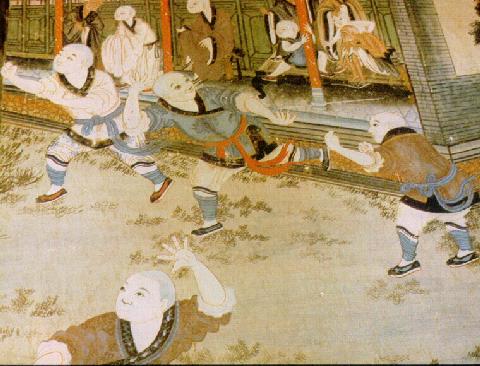
A detail of a gigantic mural in the Shaolin Temple showing Shaolin monks during the Ming Dynasty, between four to seven hundred years ago, practicing combat application. It is illuminating that Shaolin monks in the past used Shaolin kungfju patterns, and not freestyle fighting, for combat, and they used stances, not bouncing about.
Question 1
Can one, who is a complete disbeliever in the whole concept of chi, and doesn't focus or visualize, but just performs the physical movements and breaths correctly, cultivate and build internal energy and produce internal force to the same level as one who is a firm believer and of focused mind? If so, how would you describe the role of the mind in the whole concept of cultivating chi for health or martial purposes.
— Lipster, England
Answer
The answer is “yes and no”, or “either yes or no”, or “neither yes nor no”. It depends on various factors.
If all other factors were equal, the answer is no. Someone who has no concept of the mind aspect of chi kung, may still accomplish high chi kung attainment, but he will not accomplish to the same level as another who understands mind.
But all other factors are almost never equal in real life. Hence, if he performs the physical movements and breaths correctly, he may actually accomplish a higher chi kung attainment than the second person who visualizes correctly but breathes wrongly.
You will have a clearer idea if you view chi kung training as triple cultivation — cultivating the physical, cultivating energy, and cultivating the mind. You can build internal energy and produce internal force by just cultivating physically, but you will achieve more if you cultivate both the physical and energy, and achieve most if you cultivate the physical, energy and mind. Someone may cultivate all the three components, but if he does so wrongly, not only he has no benefit, he would have harmful side effects.
The mind is the most important component in chi kung, irrespective of whether the training is for health, martial art or other purposes. A powerful mind, for exmple, can direct energy to where a health problem is, and work on the problem the way the practitioner wants. In martial art, an exponent uses his mind to focus internal force at his dan tian, then explode it to his hands or other parts of his body for attack or defence.
The mind is an extremely powerful tool, but is double edged. If it is incorrectly used, it can bring very harmful effects. Hence, for safety reasons, most types of chi kung, especially those taught to the populace, leave aside visualization and breathing, and use only form to generate energy flow. The attainment is much lower, but it avoids serious side effects.
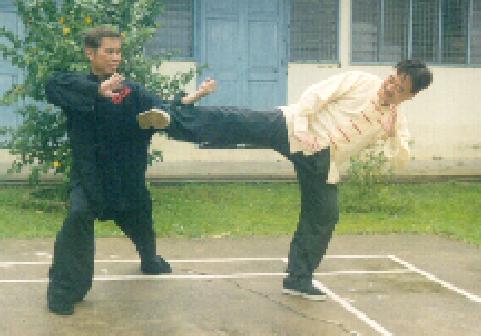
This picture taken many years ago showed Sifu Wong and his senior inner-chamber disciple, Goh Kok Hin, in Shaolin combat application using the same techniques and the same tactics as the Shaolin monks used many hundreds years ago, as shown in a famous mural. at the Shaolin Temple.
Question 2
For what reason are you of the opinion that the current Shaolin monks do not practice traditional kungfu, and that it isn't practical for real combat efficiency. I am not talking about contemporary wushu that many of them know. I am referring to true traditional forms which unfortunately are few and far between. Examples are Shao Hong Chuan, Da Hong Chuan, Tong Bei Chuan, Xiao Lohan, Da Lohan, Lian Huan Chuan, Mei Hua Chuan, etc.
Answer
The term “wushu” can refer to a few different, though related, meanings. Its dictionary meaning is “martial art”, which many people in the West would call “kungfu”. But modernized wushu as practiced by many people all over the world today and competed in international tournaments is not a martial art; it is a sport.
There are seven categories of such wushu, namely Changquan (Long Fist), Nanquan (Southern fist), Taijiquan (Tai Chi Chuan), Daoshu (Knife Techniques), Jianshu (Sword Techniques), Gunshu (Staff Techniques), and Qiangshu (Spear Techniques).
On the other hand, before modernized wushu was invented traditional kungfu was taught in China as well as in many countries all over the world. Due to various reasons, the essence of traditional kungfu, like internal force and combat application, was lost and only its external forms remained. In their effort to restore the fighting aspect of kungfu, many students and instructors resort to free sparring, and borrow techniques and training methods from karate and taekwondo, and recently from kickboxing.
All the kungfu forms or sets you mentioned above are from traditional kungfu. Nowadays you can learn these forms easily. When I was at the Pacific Mall (new China Town) in Toronto recently, I was amazed to see more than 50 traditional kungfu sets like the ones you mentioned above on sale in the form of compact disks. If you already have some foundation in kungfu or wushu, now you don't need a master or an instructor to teach you the sets. Buy whatever sets you wish to learn, and you can learn them in a week. But what you will learn are kungfu sets or kungfu external forms, not genuine kungfu.
Frustrated that their modernized wushu cannot be used for combat, many wushu masters, including some modern Shaolin monks, turned to traditional kungfu. But the essence was missing, they could only perform external kungfu forms, and had no internal force or combat application.
When I say that current Shaolin monks do not practice traditional kungfu, I am stating a fact, not an opinion. This statement may be delicate. I have tried to avoid mentioning this fact as much as I could, but frequently I have been pushed to my limit.
The Shaolin Temple is the source of my inspiration and learning. Its philosophy and arts have contributed greatly to my joy and well-being, as well as to those with whom I have shared these teachings. I would certainly not want to say anything to discredit the Temple or its monks. Although saying that current Shaolin monks practice wushu and not kungfu, is nothing discreditable, it may be misconstrued as they are inferior to genuine kungfu masters.
But the actions of some current Shaolin monks or their agents disappointed me. I am sad that some monks publicly eat meat and drink alcohol, blatantly displaying their disregard for Mahayana traditions and sensitivity. I am sad that they or their agents regard themselves as the only true Shaolin disciples, and all others as deviants from the Temple. And I am abhorred at their attempt to patent the term “Shaolin” worldwide so that only they and no one else in the world can use the term!
There is nothing wrong with modern Shaolin monks practicing and teaching wushu. It is a majestic art, demanding much dedication. And the present Chinese government overwhelmingly favours wushu over kungfu. But if someone practices wushu, and pretends that it is kungfu, then something is wrong. The crucial difference between wushu and kungfu lies not in their forms, but in their function. Wushu is a demonstrative sport whereas kungfu is a martial art.
Question 3
As proof of their true inefficiency, I was told that this is because they only seem to spar using san shou skills. As far as I can make out, real fights do not play out in a sequence. There are no stances. Things are too quick to spring into a nice stance all the time. Real combat is completely unlike choreographed sequences so entirely warped by the movies.
Answer
If you can use kungfu techniques in sparring, you would beat your opponent more often. You could use kungfu techniques if you were trained methodoically and sysremmaticalluy. But most people can't use kungfu techniques; they spar like children, or at best like kickboxers, karatekas or taekwondo exponents. It is also pertinent to mention that in the 19th and 20th centuries, many foreign masters of various styles went to China to challenge kungfu masters, and the kungfu masters beat their opponents convincingly.The term “san shou” literally means “miscellaneous hands”, and refers to miscellaneous or individual techniques to overcome a combat situation or a short series of combat situations. It is also called “san da”, or “miscellaneous hitting”. For example, if someone throws you a series of punches, not in any pre-arranged order, and you defend against them, what both you and your opponent have used is “san shou”.
San shou can be executed in any martial art techniques. If you practice kungfu, logically you would use kungfu techniques in your san sau; if you learn karate logically you would use karate. If you practice kungfu, but use karate, kickboxing or free fighting in your san shou, that would be illogical. Why would you practice kungfu in the first place?
Embarrassed by criticisms that their wushu cannot be used for combat, wushu masters in China incorporated san shou into their repertoire. Accordingly, Shaolin monks at the Shaolin Temple in Chna, who practiced wushu, also experimented with san shou. They then planned an international san shou competition with the intention to show that wushu can be sued for fighting. I know this quite well because one of my students was actually involved in its preparation.
This happened many years ago, probably even before the present generation of Shaolin monks began to learn wushu. My student was a master in his own right, and this occurred before he learned Shaolin Kungfu from me. At that time he was staying in China working on his master's degree, and his topic was Shaolin Kungfu. (Now he has completed his doctorate degree.) He was the only foreigner in the preparation, for two reasons. One, he very easily beat the best Shaolin monks in sparring. Two, he was a good source to obtain outside information on sparring competitions.
What the Shaolin monks practiced for the san shou competition was not techniques from Shaolin Kungfu, not even from wushu, but from Western Boxing, and the standard was low. My student advised the monks against holding the competition, saying the standard of sparring outside China was much higher. But preparation had gone too far ahead for cancellation. The competition was held, and was a disaster for the Shaolin monks.
By now the standard of san shou, using boxing and kickboxing techniques, have improved vastly amongst some current Shaolin monks. Recently I saw a video showing a well known Shaolin monk exhibiting san shou techniques. His punches and kicks were fast and impressive, but they were boxing and kickboxing techniques. There was not a single pattern from the wushu, or kungfu as he called it, he taught.
There is no doubt that Shaolin techniques can be effectively used for sparring or real fighting, though not many people today can do so. I speak with conviction because my masters did so, I myself did so, and many of my students are doing so. And stances are very, very important. Looking back at the many sparring sessions and a few real fights in my younger days, I would say that the most crucial factor enabling me to come out of combat unhurt was my stances!
If you were at my recent chi kung courses in Brighton, you would have seen typical Shaolin and Taijiquan techniques in combat. A photographer from a kungfu magazine wished to take some photographs for illustration of kungfu combat. My students posed for the photographs. It was impromptu. There was no pre-arrangement, no choreographed sequences. One student attacked and another responded spontaneously using typical Shaolin or Taijiquan patterns. Then they recalled the impromptu combat sequences they used, pattern by pattern, for the photographer.
Incidentally the example of Ronan in the photograph taking (on another day) demonstrated how easily my students went into their stances in free sparring. Before he learned Shaolin Kungfu from me, Ronan was a boxer. I asked Ronan to pose as a boxer and attack me, as I wished to illustrate, in response to a reader's question in my Q-A series, how one could effectively use Shaolin Kungfu against Western Boxing. As Dan correctly said, after about a year of systematic training, they (including Ronan) could no longer fight without naturally going into their stances. As Ronan went into his stances spontaneously, his footwork was so unlike that of a boxer that I had to ask Darryl to substitute him!
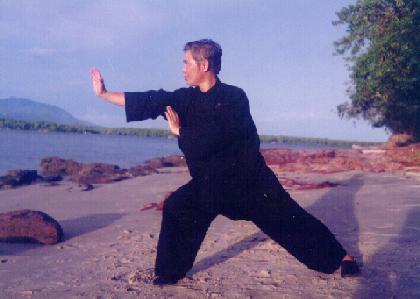
Here Sifu Wong demonstrates the pattern “Fierce Dragon Across Stream”, which is the same pattern demonstrated by the Shaolin monk of yore in the mural shown above. However, the Shaolin monk used a right fist, whereas Sifu Wong uses a right palm. In Chen Style Taijiquan, this pattern is called “Lazy to Roll up Sleeves”.
Question 4
My Shifu, (a modern Shaolin monk) says that “freestyle fighting” is the 'heart' of Shaolin Kungfu. I haven't progressed too far in the Temple yet, but from what I know the techniques are taken from the forms. Very few are taught, but they are studied in great detail, and used in the “freestyle” combat. It is not the forms themselves that are the fight. There is no guaranteed form of attack for any fight. Do you have any opinions on this?
Answer
Yours is a very common case because employing kungfu patterns for real combat or free sparring is so rare today. This is because the essence of kungfu has been generally lost, those who can still fight or spar using kungfu patterns are the exception. But when Shaolin monks or other masters themselves advocate that "freestyle fighting is the heart of Shaolin Kungfu”, it becomes alarming. It sounds the warning that if nothing is done, genuine Shaolin Kungfu will be lost forever within the next two generations.
Freestyle fighting may be the heart of modernized wushu because its exponents do not know how to fight using the patterns they perform in solo, but it is certainly not in genuine Shaolin Kungfu, or any genuine kungfu. Just a quick look at any kungfu literature or illustration will show that kungfu masters in the past used kungfu skills and techniques in combat.
Some literature even described the special skills or techniques of the masters. For example, the Shaolin masters Fong Sai Yoke and Wong Fei Hoong used “no-shadow kicks”, and the Taijiquan master Yang Lu Chan used “Grasping Sparrow's Tail”.
Very fortunately, the gigantic murals in the White Robe Hall of the Shaolin Temple in China still stands. The gigantic murals are testimony to the kind of Shaolin Kungfu practiced during the Ming Dynasty, which was between four to seven hundred years ago. They show Shaolin monks sparring, and they used Shaolin patterns, like the ones kungfu and wushu exponents practice today.
Unless the person in question is ignorant, to advocate that freestyle fighting is the heart of Shaolin Kungfu is to imply that all the past masters who said they used kungfu patterns in combat were liars, or all those who practice kungfu patterns for combat today are fools.
Then, why can't those who practice or study kungfu or wushu forms use them for combat? The reason is simple — they have never methodically practiced how to use them for combat. Why haven't they done so? The reason is again simple — their teachers have never taught them so. Why haven't their teachers taught them? Again the answer is simple, though many may not like it. Their teachers simply don't know.
If you wish to use your kungfu or wushu techniques for combat, you just have to learn and practice doing so methodically. If you go straight to free sparring immediately after form training, you will fight freestyle, which is another way of saying you will fight like children.
If you train punching and kicking methodically, like what some current Shaolin monks do, and use them in combat, you will not fight freestyle; you will fight like boxers or kickboxers.
If you want to use kungfu patterns in sparring, you must methodically learn and practice how to use kungfu patterns in sparring. It is as simple as that. If you only study kungfu forms, even in great details, but have never learnt how to use them in sparring, you will not know how to use them in sparring. Hence, if you attempt sparring, you will spar freestyle.
If you have been methodically trained to spar using kungfu patterns, when an opponent attacks you, irrespective of whether he uses kungfu forms or any other martial art forms or use freestyle, you will spontaneously respond with the kungfu patterns that you have been trained in. You will not need to think what pattern to use, or what stance to jump into; you will just respond correctly and spontaneously.
It is the same in any other art. If you have been methodically trained as a goalkeeper, if someone shoots a ball at your goal, you do not need to think of which leg or hand to move first, you just leap out spontaneously to save the goal in the way you have been trained in. If you are a trained swimmer, if someone throws you into water, you will not need to think what strokes to use or how to breathe, you will just swim the way you have been trained in. If you can't — in sparring, football, swimming or anything — it means you have not been trained correctly, or you have not been trained sufficiently, or you have not been trained at all.
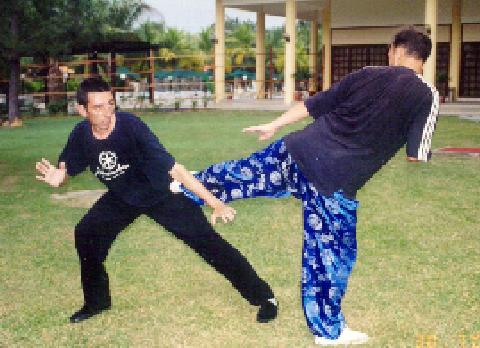
The kungfu patterns used by the Shaolin monks in the past are also found in Taijiquan, which evolved from Shaolin. The picture above was taken during a free sparring session at the Special Taijiquan Course held in Malaysia in July 2002. All the participants, who are inner-chamber disciples of Sifu Wong, used Taijiquan patterns and proper stances in their free sparring, not freestyle fighting and bouncing about.
Question 5
From what I have heard, a large part of strengthening and improving is by extensive cultivation of chi in the various internal exercises you teach. This is supposed to substitute a fair amount of the extreme external training such as lifting weights and running or other very strenuous exercises that builds and strengthens ones body. I have never heard from any other system that one should substitute demanding external training with harnessing chi. Chi of course is an integral part of training; external kungfu training and chi go hand in hand. But internal exercise obviously doesn't, or shouldn't, substitute gruelling external training.
Answer
It is true that we practice little or no extreme external training or very strenuous exercise like lifting weights and running, but this does not mean we do not pay attention to external training or to build and strengthen our body.
In our school, Shaolin Wahnam, we believe in and actually practice both external and internal training, both hard and soft approaches, and we are guided by the triple cultivation of body, energy and mind.
Our training or cultivation is integrated, not isolated one by one. In other words, we do not first do external training then internal training, first soft approach then hard approach, first the body, then energy and then mind. All these aspects are involved together whenever we train, though for some particular purposes we may emphasize one aspect more than another.
For example, when we perform a kungfu set, we do not merely perform the forms. Doing so will be only external training. We also pay much attention on how to regulate our breathing, which is energy training, and on how to focus our mind, which is mind training. Depending on the specific objectives of the training session in question, we may place more emphasis on one aspect over the others, or we may place equal emphasis on all.
For example, if the specific objective is to perfect a defence module against a particular attack, we would pay more attention to form, and regulate our breathing and focus our mind appropriately to achieve the best effect.
If the objective is to explode force to bounce off an opponent's attack, our emphasis would be on energy management, such as how to accumulate our chi at the dan tian and direct it out to our defence explosively, and we use the best physical form and state of mind for this purpose.
If the objective is to train correct judgment, we would pay more attention to mind, like entering into an appropriate mental and bodily state where we are totally relaxed and sharply focused, while maintaining our correct form and breathing.
Such a division into emphasizing different aspects in different training sessions is for the convenience of training. In application, in sparring or in our daily life, we respond to the situation correctly and spontaneously, without worrying about what forms, breathing mode or mental state to use. For example, when an opponent grabs our arm or when we alight from a train, we spontaneously and elegantly release the grip or leave the train, without worrying about form, energy or mind.
Hence, it is incorrect to say that in our school a large part of strengthening and improving our body is by extensive cultivation of chi. I often remind my students that chi kung is not just chi cultivation, but equally jin cultivation and shen cultivation, i.e. chi kung is not just cultivation of energy, but equally cultivation of the physical body and cultivation of mind. If a person has a lot of energy, or is mentally sharp, but is slow and clumsy in his movements, then he has not done well.
Our belief of equal importance of body, energy and mind, though we may at times place emphasis on one aspect for particular reasons is a main philosophical difference, and consequently a main difference in methodology, between our school and many other schools. For example, many martial art schools place much emphasis on physical training like weight training and running, but we don't. Some spiritual disciplines only train the mind to the extent of neglecting their body, but we train both our mind and body.
You comment that “chi is an integral part of training; external kungfu training and chi go hand in hand” is only a philosophical ideal. In practice it is usually not true. Most external kungfu and external martial art schools have no idea of chi. For example, almost all external schools, and even many internal schools, perform their sets or katas without paying attention to breath control. Some martial artists do not even believe chi exists.
Ours is not the only school that places emphasis on all the three aspects of body, energy and mind. In fact, all traditional kungfu schools do so, or at least did so and at least in theory, though the emphasis may not be of equal proportions. The concept of jin, qi and shen, or form, energy and mind, is fundamental in kungfu and chi kung, but due to various reasons many schools today have lost the aspects of energy and mind.
Shaolin Kungfu, Taijiquan, Baguazhang and Hsing Yi Kungfu are particularly well known for their emphasis on energy and mind besides form. In fact, in Taijiquan form is sometimes regarded as secondary to energy and mind, as a means to train internal force and attain spiritual fulfillment. The term “Hsing Yi” literally means “form and intent”, signifying equal importance on both the external and the internal.
Due to various reasons, many kungfu schools today place emphasis only on form. A notable example is the many derivatives from Shaolin Kungfu, such as Hoong Ka Kungfu, Lau Ka Kungfu and Choy-Li-Fatt Kungfu. This was because their first patriarchs and early masters were revolutionaries, who devoted their time to training fighting techniques for overthrowing the Manchurian government, rather than to training energy and mind for spiritual fulfillment.
Another notable example is modernized wushu. This was because the Communist government which started wushu did not believe in spiritual development, and like many materialistic Westerners, did not believe in chi. Wushu is also devoid of fighting aspects because originally it was invented for sport. But wushu exponents, due to their strong connection with Chinese culture, should have heard of chi, but most of them do not have any experience of it.
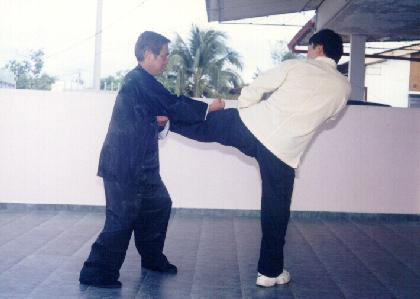
Notice that the pattern used by Sifu Wong here and the pattern used by the Shaolin monk in the mural shown above are similar. The stances are the same, and they are called Stream-Character Stance or Four-Six Stance.
Question 6
I think you would agree that the one concept mutually accepted by any martial art system since the beginning of time is simple — hard work. Blood, sweat, toil and tears. Period point blank. This is the only way you will become stronger. There is no short cut. I have never come across any other system that replaces so much of the extremely tough workouts with chi cultivation. So I find it hard to comprehend why your system of teaching does not encourage more plain old hard work.
Answer
Hard work is a basic requirement for any success, be it in kungfu, spiritual cultivation or business. But hard word is not necessary blood, sweat, toil and tears. In fact it shouldn't be. Why should you bleed, sweat, toil and wail — literally or figuratively — in any art, be it wushu, Chan cultivation, dancing or folk singing, when you practice it as a hobby?
My chi kung, Shaolin Kungfu and Taijiquan courses involve hard work. My Intensive Shaolin Kungfu Course is very, very hard work. I often say jokingly that by comparison my chi kung course is for lazy people, and my Taijiquan course is for children to play.
But actually those who attend my chi kung and Taijiquan courses are smart; they do not have to undergo the very hard work in Shaolin Kungfu, yet get more than enough benefits for their needs. Then, why do my students attend my Shaolin Kungfu course? They want the best and are willing to work very hard to get it.
But the hard work we do is very different from what you imagine. You toil and sweat for an hour, and return home tired and in pain. You have to rest, or cool down, for another hour before you can do any useful work, or even to enjoy yourself. You work hard, as Vince correctly pointed out elsewhere, like a water-buffalo.
Students at my Yi Jin Jing class flick their fingers three times, the whole practice taking only about 5 minutes, and they can develop sufficient internal force to enable them to work or enjoy themselves the whole day! Students at my Intensive Shaolin Kungfu Course spar or train internal force, which is very demanding, for eight hours, then return home, have a shower and immediately go out with their dates.
If you are used to water-buffalo training and think that it is the only way to make you strong, even if we skin your buffalo hide you would not believe what I have said is true. This is one main reason why some people, but not you, slander me behind my back, saying that I am a fraud. They, and you, had a golden opportunity to experience these effects themselves at my chi kung courses held recently, but they chose to argue verbosely instead of directly experience the effects or otherwise to confirm or debunk my claims.
I wish to add that these results in my courses, which may seem impossible to many people, are not the exception; they are the norm. That means anyone who attends my courses is expected to have these results.
The reason why you have “never come across any other system that replaces so much of the extremely tough workouts with chi cultivation”, is simple. You are extremely limited in your views and exposure.
As I have said earlier, mine is not the only system to use chi cultivation to replace the extremely tough workouts you have in mind. There are many others. Genuine Taijiquan and Baguazhang masters are very powerful, more powerful than weight-lifters and body-builders, but they never use water-buffalo workouts. .
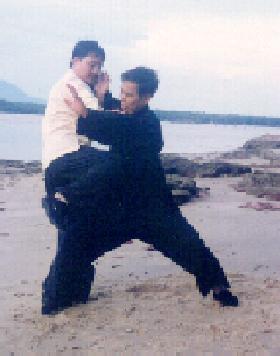
In a sparring practice, Goh Kok Hin manges to get past Sifu Wong's defence and executes a knee attack at close quarters at Sifu Wong's ribs using a pattern called “Jade Girl Kicks Shuttle”.
Question 7
I'm not saying I don't believe in internal training. I believe one is doing himself a great disservice if he studies kungfu without chi kung, and vice versa. They belong together. But one would also do himself a great disservice if he is to substitute difficult external training with chi cultivation.
Answer
Again, your comment that “one is doing himself a great disservice if he studies kungfu without chi kung, and vice versa” is only a philosophical ideal. In real life, very few people have the chance to practice kungfu with clhi kung, and, on the other hand, to practice chi kung with kungfu. “Practice” is a better, more appropriate term than “study”.
My sifu, Sifu Ho Fatt Nam, advised me many years ago, “If you wish to soar the heights of kungfu, you must train chi kung”. Indeed, all the advanced skills of kungfu like Golden Bell, Cosmos Palm and One-Finger Zen are possible only through chi kung.
Nevertheless, a kungfu master who only trains the physical aspect of kungfu without its energy aspect, i.e. without chi kung, can also attain a very high level. In fact, many formidable fighters today, in kungfu as well as other martial arts, do not know chi kung.
If all things were equal, a purely physical kungfu master can never reach the level of a kungfu master who also practices chi kung. The former would not have the depth of internal force, the speed of movement, the abundant stamina and sharpness of mind of the latter. But things are not equal. Thus, a purely physical kungfu or martial art master can defeat another who also has chi kung.
It is easy to see why knowing chi kung is a great advantage to kungfu training. But what about the other way round? How does training kungfu enhance the attainment of a chi kung practitioner, apart from the obvious advantage that he can defend himself?
Many people often comment that I am always bouncing with energy, although I am already sixty. I believe the reason is that I practice not just chi kung but also kungfu. If I practice only chi kung, I may have a lot of energy, but I may not be bouncing with it.
The nature of kungfu training is that you have to pay much attention to agility and mind, besides energy, whereas agility and mind may not be as demanding to a chi kung practitioner. Generally speaking, if he is healthy and has vitality for work and play, a chi kung practitioner would have fulfilled his basic chi kung aspirations. He normally does not have to worry whether a samurai sword is coming down fast on him from behind. But it is not so for a kungfu exponent. He must have the sharpness of mind to sense it from behind, even though he may not see it, and he must be agile enough to jump out of the sword's path.
Regarding your comment that one would also do himself a great disservice if he is to substitute difficult external training with chi cultivation, it is actually the reserve. You will read about my explanation on “water-buffalo training” and “smart training” Questions and Answers 3 and 4 in the January Part 3 issue.
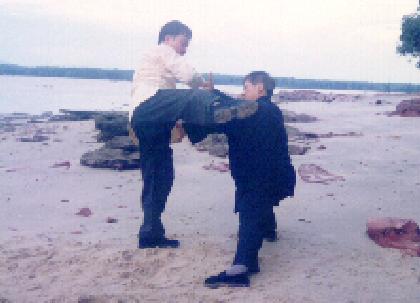
Yet Sifu Wong conter-attacks excellently, using the tactics of “no defence, direct counter” and “Strike when the opponent's attack is just spent”. He moves his right leg a big step diagonally to his right, simultaneously “floating” up Goh's left hand with his own right hand, and striking Goh's groin with his left tiger-claw.
Question 8
I read in your books that having sex will affect a person's progress in Chi Kung. Since it is normal for people to have sex 2 to 3 times a week these days, wouldn't it be difficult for modern people to achieve good progress in Chi Kung? Should a person who wants to be good in Chi Kung cut down on the frequency of sex in the first few months of his practice, or are there other ways to manage this?
— Ricky, Singapore
Answer
You are right. He may cut down on sex or there are other ways to manage this. This choice depends on a few variables. The following background information will help him to choose wisely.
One variable is his condition, like whether he is sick or healthy, and whether his work and daily living are hectic and stressful or relaxed and pleasant. Another variable is his needs and aspiration, like whether he is an ordinary nine-to-five worker or he is training to take part in a world freestyle fighting competition. A third variable is the type of chi kung he practices and his level of attainment.
Next he should understand how chi kung works, and what it is for. Basically it is to improve his energy volume and flow, and to enhance his life as well as the lives of other people, especially his family and friends.
Hence, if he is weak and sickly and his chi kung is of a low level, it is advisable for him to abstain from sex for the first three months to build up his energy foundation. On the other hand, his chi kung may be of a high level but he is preparing for some important task involving vigorous activity, he may also abstain from sex for the time being to conserve his energy for future use.
But for most ordinary people, who have been enjoying wholesome, regular sex before starting chi kung, it does not make sense that an art that is supposed to increase his energy, which is needed for sex, should distract him from his enjoyable acts. The same philosophy applies to his other wholesome pleasures. If he enjoys a little drink, an occasional smoke, and good food without ill effects, it does not make sense to deny himself these little pleasures just because he practices chi kung, unless of course he does so for some other more urgent or important purposes.
Let us look at a simple analogy. Suppose you have been taking your family out for dinner once a while, and this has made all of you happy. Now you are going into business to increase you cash volume and flow. You will have to decide whether to miss the family dinner outings to invest more money into your business so that, hopefully, you can take your family for expensive overseas holidays instead, or to carry on with the dinner outings but with less investment into your business.
But you must not confuse yourself with means and ends, as some people often do. You would be a fool, if, after all the sacrifices you and your family have made, and despite making a lot of money in business, you have no time even to have an ordinary meal with your family at home. Remember that practicing chi kung, like going into business or to work from nine to five, is a means to make your and other people's lives meaningful and rewarding. Having wholesome sex is an important aspect of a meaningful, rewarding family life.
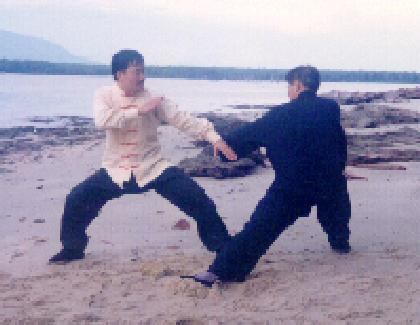
Goh Kok Hin brings his kicking leg backward into a sideway Horse-Riding Stance, and sweep at Sifu Wong's arm using a pattern called “Horse-Riding Tiger-Tail”.
Question 9
I attended your Intensive Chi Kung Course in Malaysia nearly two years ago. I don't expect you to remember me because I know you've seen many people since, but I was the 16 year old who came with his mother (she didn't take the course). I remember you saying that the class had a particularly good group of people.
I've reached a point in my practice where I'm unsure what to do next. I have been awakened to the truth of what reality is. About 6 or 7 months ago I went through a period where I was having one almost every time I practiced. And then I started having them without even practicing chi kung. I may just be going on about my normal activities and it will flash before me when I'm calm or relaxed, and focused a little more than normal. For example, I was eating a meal today and “saw” that the food I was eating wasn't really there, was empty, and then “saw” that I “wasn't” there either!
And this is where I am at with my dilemma. What's next? It seems like I can “exist” in “cosmic reality” for short flashes almost on demand. You teach us to have aims and objectives. Where do I go from here? What aims and objectives should I set?
— Ryan, USA
Answer
Of course I remember you, Ryan. You, like Alex and many others, are some of my youngest and very intelligent students who have progressed exceedingly fast. I am very happy with your progress.
Fast progress may sometimes be a “problem”, and you are now experiencing one. Before discussing your “problem”, I would like to say how very fortunate you are, although you already know it, and have thanked me sincerely and profusely. If I remember correctly, you are one of those who say the course is worth more than a thousand times the fee you paid. You told me how joyful you were when chi opened your heart.
This reminder has a lot to do with your “problem”. What you have experienced is called in Zen terms “satori”, or spiritual awakening. In the past, people sacrificed a lot, including leaving family life, to enter monasteries to become monks to experience satori.
They chopped firewood, swept temple floors, listened to sermons, did a lot of meditation, buried themselves in koans, and sometimes were shouted at or hit by their masters (which were actually expedient means to help them) just to experience satori. They would be very happy and prostrated to their masters if they could attain a satori after a few years.
Now you have had many satoris just after two years of learning chi kung from me, and you practice not in the stringent environment of a monastery but in the comfort of your house. An analogy will enable you to view your situation better and offer you a few solutions.
Suppose a school-leaver set out to become a millionaire. He knew the road was long and difficult but he was ready to work hard. He knew that millionaires were made after they were 50. But for some reasons he became a billionaire at 25. For the first few years he was very happy. The first small car he bought was a great joy. But soon he became bored. His driver-driven limousine and palace-like mansion did not mean anything to him. He had a “problem”.
His “problem” is like yours, with two notable differences. One, it is easy to see his advantages of having a lot of money, but it is not easy to see your advantages of having a lot of chi. Two, your benefit is much greater than his, though most people may not believe or understand it. His benefit is mundane, limited to this world, but yours is cosmic, has unlimited potential, and when you are ready it enables you to solve all problems of life and death and attain infinite and eternal bliss!
It was for this reason that monks sacrificed all worldly pleasures to seek satori, which would confirm for them from their own direct experience the validity of their goal and methodology. They would then set out for the most noble task, to seek Enlightenment.
With some cosmic wisdom, what would you suggest for the young billionaire to overcome his “problem”? He could set out for his most noble task, according to his personal philosophy and vision, which might be building an international business empire where money never flowed dry, or becoming the greatest world philanthropist where no one ever got hungry.
Or, in a less idealistic but still very noble way, he could use his money to enhance his life and the lives of others, in whatever suitable ways he thinks fit. Thirdly, the most prosaic but perhaps the most practical, he could forget about the “problem” and enjoy his good fortune.
Now, have you got your own solutions? You could set out for the most noble task, leave your university, leave your family, leave everything to work for Enlightenment. Or you could choose the second course. Use your abundant energy and powerful mind to enhance your life and the lives of others. Or do the most practical. Forget about your “problem” and enjoy your fortune.
Obviously, the first course is not for you — yet. Your best choice, in my opinion, is a mixture of the second and the third, in whatever proportion and in whatever order. You could, for example, use your energy and mind — usually in ways you need not be technically conscious of — to make yourself, your mother and your teachers happy by doing well at university. When the going becomes tough, which would not occur often once your energy and mind have become powerful, you could forget about everything and just enjoy yourself listening to the leaves sing and the clouds dance.
But you must always remember. You must never, never, never willfully use your powerful energy and mind to harm anybody. This is a basic teaching of our school, much emphasized by Sigong Ho Fatt Nam.
